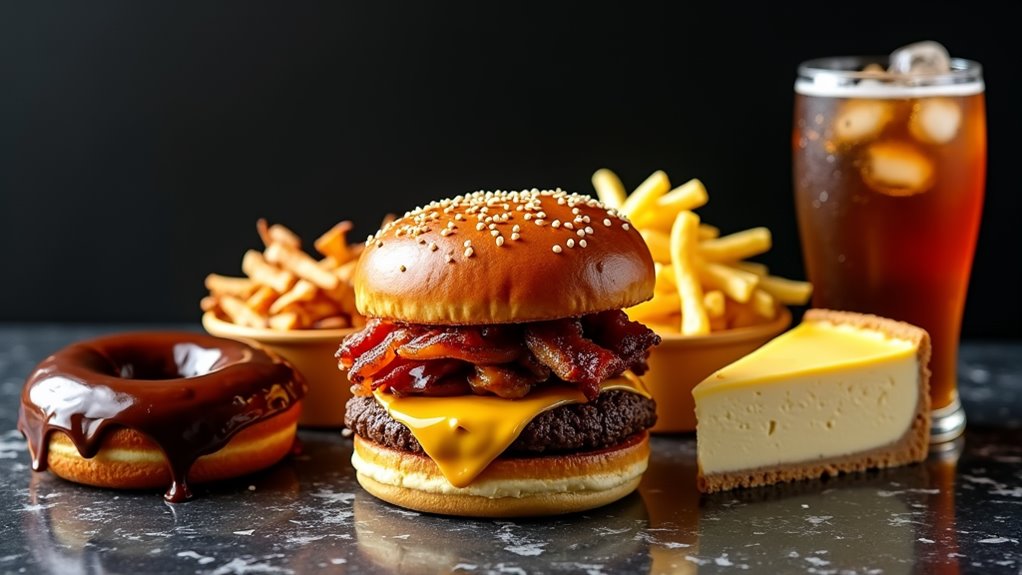These 5 Foods Are Ruining Your Weight Loss Efforts!
You’ve been working hard to shed those extra pounds, but your scale isn’t budging. The culprit might be hiding in plain sight on your “healthy” shopping list. While you’re making conscious efforts to eat better, certain foods marketed as nutritious options could actually be sabotaging your weight loss goals. Before you grab that granola bar or low-fat yogurt, discover why these five seemingly innocent foods might be the reason you’re not seeing results.
Granola and Breakfast Cereals: The Hidden Sugar Trap
While granola and breakfast cereals might seem like healthy breakfast choices, they’re often loaded with hidden sugars that can sabotage your weight loss goals. Many popular brands pack up to 12 grams of sugar per serving, and most people pour double the recommended portion size, unknowingly consuming significant calories before their day begins.
These seemingly innocent foods ruining weight loss often contain refined grains, honey, dried fruits, and various forms of added sugars disguised under names like brown rice syrup or barley malt. You’ll find yourself hungry again shortly after eating them due to their high glycemic index, leading to increased cravings and potential overeating later in the day. In fact, many protein bars are also packed with hidden sugars and unhealthy fats, which can further undermine your diet efforts.
Instead, join the growing community of health-conscious individuals who’ve switched to protein-rich breakfast alternatives like Greek yogurt with fresh berries, eggs with vegetables, or overnight oats made with minimal sweeteners.
These choices will keep you satisfied longer and support your weight loss journey.
Low-Fat Flavored Yogurt: When Healthy Goes Wrong
Despite its reputation as a diet-friendly snack, low-fat flavored yogurt often derails weight loss efforts due to its shocking sugar content. When manufacturers remove fat from yogurt, they typically compensate by adding sugar to maintain taste. A single serving of low-fat flavored yogurt can contain up to 30 grams of sugar – that’s more than some candy bars!
You’re better off choosing plain, full-fat Greek yogurt instead. It’ll keep you feeling fuller longer, thanks to its protein content and healthy fats.
Plus, you’ll avoid the blood sugar spikes that can trigger cravings and overeating later in the day. If you crave sweetness, add fresh berries or a drizzle of honey – you’ll control the amount of sugar while getting real nutrients. Many of your fellow health-conscious friends have already made this switch and discovered they feel more satisfied and energized throughout their day. Additionally, understanding that the type of calories consumed matters can help you make healthier food choices in the long run.
Store-Bought Smoothies and Juices: The Liquid Calorie Culprit
Many people reach for store-bought smoothies and juices as a “healthy” alternative to soda, yet these beverages can pack an astounding amount of sugar and calories.
You’ll find that a single bottle often contains multiple servings, though most of us drink the entire thing in one sitting.
What makes these drinks so problematic for your weight loss journey? Consider these eye-opening facts:
- A 20oz store-bought smoothie can contain up to 50-70 grams of sugar, equivalent to eating 3-4 donuts.
- Most bottled juices lack the fiber found in whole fruits, leading to blood sugar spikes.
- Commercial smoothies often include added sugars, syrups, and caloric thickeners.
If you’re committed to your weight loss goals, you’re better off making smoothies at home where you can control the ingredients. Maintaining a caloric deficit is essential for effective weight loss, so be mindful of what you consume.
Try blending whole fruits with leafy greens, adding protein powder, and skipping added sweeteners. Your body will thank you, and you’ll still get to enjoy delicious drinks.
Dried Fruits: Nature’s Candy in Disguise
Although dried fruits offer concentrated nutrients and convenience, they can sabotage your weight loss efforts due to their deceptively high calorie and sugar content. When fruits are dried, their sugars become concentrated, making it easy to overeat without realizing it. Just a quarter cup of dried cranberries contains as many calories as two cups of fresh ones.
| Fruit Type | Fresh (1 cup) | Dried (1/4 cup) |
|---|---|---|
| Cranberries | 46 calories | 123 calories |
| Grapes | 62 calories | 120 calories |
| Apricots | 74 calories | 313 calories |
| Mangoes | 99 calories | 307 calories |
| Blueberries | 85 calories | 127 calories |
If you’re watching your weight, stick to fresh fruits instead. They’ll fill you up with fiber and water while providing fewer calories. When you do choose dried fruits, measure your portions carefully and treat them as concentrated energy sources rather than snacks you can mindlessly munch. Remember that hydration plays a crucial role in managing hunger and can help you avoid overindulging in high-calorie foods.
“Diet” Snacks and Sugar-Free Treats: The Artificial Sweetener Dilemma
While “diet” snacks and sugar-free treats promise guilt-free indulgence, they often contain artificial sweeteners that can actually hinder your weight loss goals. Research suggests these sugar substitutes can disrupt your metabolism and trigger increased cravings for sweet foods.
You might think you’re making a smart choice by choosing sugar-free options, but artificial sweeteners can affect your body in surprising ways:
- They can confuse your brain’s reward system, leading to overconsumption later.
- They may alter your gut bacteria, potentially affecting how you process calories.
- They can increase your tolerance for sweetness, making natural foods taste less appealing.
When you’re trying to lose weight alongside others on the same journey, it’s important to recognize that “diet” foods aren’t always your allies. Additionally, some detox teas also contain laxative ingredients, which can lead to dehydration and digestive issues.
Instead of reaching for artificially sweetened treats, try satisfying your sweet tooth with small portions of naturally sweet foods or fresh fruit.

